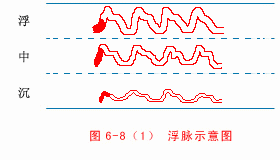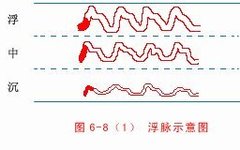

 Floating Pulse (Fu Mai):The floating pulse is superficial, felt just beneath the skin, and can be detected with light pressure. When pressed harder, the pulse may slightly diminish but does not feel weak or empty. In summary, a floating pulse indicates that the patient has an exterior condition, suggesting a mild illness where the external pathogen has just entered the body, and the body’s righteous qi is still strong, fighting against the external pathogen, thus the pulse appears floating and strong. If the exterior pulse is floating but weak, it indicates that the patient is usually weak, known as Exterior Deficiency Syndrome (Biao Xu Zheng). If a long-term illness presents with a floating and weak pulse, it indicates a serious condition with floating yang qi.Deep Pulse (Chen Mai): The deep pulse is the opposite of the floating pulse, where the pulse is felt deeper, and light pressure may not reveal any pulsation, while only heavy pressure shows a distinct pulse. The deep pulse indicates an interior condition, with a strong deep pulse suggesting an excess of pathogenic qi in the internal organs, while a weak deep pulse indicates Interior Deficiency Syndrome (Li Xu Zheng), referring to a deficiency of righteous qi. Weakness in the spleen or kidneys can also present as a weak deep pulse. A deep pulse can also indicate water retention in the limbs.Slow Pulse (Chi Mai): A slow pulse is defined as having fewer than four beats per breath, or less than sixty beats per minute. This slow pulse indicates the presence of cold pathogens. Cold causes blood to congeal, slowing its circulation, hence the pulse is slow. A strong slow pulse indicates Excess Cold Syndrome (Shi Han Zheng), while a weak slow pulse indicates Deficient Cold Syndrome (Xu Han Zheng), primarily due to weak yang qi. This cold is caused by yang deficiency, similar to the cold of winter when sunlight is weak, not necessarily indicating an actual cold pathogen.Rapid Pulse (Shu Mai): The rapid pulse is the opposite of the slow pulse, defined as having more than five beats per breath, or over ninety beats per minute. A fast pulse reflects heat. A strong rapid pulse indicates Excess Heat Syndrome (Shi Re Zheng), where the heat pathogen accelerates blood flow, while a weak rapid pulse indicates Deficient Heat Syndrome (Xu Re Zheng), which arises from internal imbalances of yin and yang, leading to internal heat. A rapid pulse can also indicate Yin Deficiency Heat (Yin Xu Neire), where the pulse is thin and rapid due to insufficient yin and blood.Thin Pulse (Xi Mai): A thin pulse is characterized by a small, delicate feeling under the fingers, often described as thread-like, but the pulse is distinct and can be counted. The thin pulse indicates deficiency syndromes, primarily Yin Deficiency (Yin Xu) and Blood Deficiency (Xue Xu), where insufficient yin and blood lead to a small pulse. In chronic deficiency syndromes, the pulse may also be thin. A simple yang deficiency may present as a weak pulse, while a more severe yang deficiency may show a floating and weak pulse.Slippery Pulse (Hua Mai): A slippery pulse feels smooth and flowing, like beads rolling on a plate. It indicates phlegm or phlegm retention. When phlegm obstructs the flow of qi and blood, the pulse appears slippery. In cases of high fever, the heat accelerates blood flow, resulting in a slippery pulse. After conception, the pulse may also be slippery due to the surge of qi and blood nourishing the fetus.Rough Pulse (Se Mai): The rough pulse is the opposite of the slippery pulse, characterized by a coarse and uneven feeling, like a knife scraping bamboo, indicating stagnation. A rough and weak pulse suggests insufficient essence and blood, leading to poor circulation. A rough and strong pulse indicates qi stagnation and blood stasis, where the pulse pathway is obstructed.Knotted Pulse (Jie Mai): A knotted pulse is slow and irregular, with periods of cessation. It indicates cold phlegm, blood stasis, or masses that obstruct the pulse pathway, causing slow and intermittent blood flow. If the knotted pulse is weak, it indicates heart blood deficiency. Occasional cessation without other symptoms is not considered pathological, but frequent cessation with a slow pulse indicates a serious condition.Intermittent Pulse (Dai Mai): An intermittent pulse is characterized by a slow and regular cessation, such as stopping after every five beats or every three beats. It indicates a decline in organ qi, suggesting a serious condition. Occasionally, pain or fright may also present with an intermittent pulse, indicating disharmony of heart qi, but this does not necessarily indicate a severe illness.Rapid Pulse (Cu Mai): A rapid pulse is characterized by quick beats with irregular intervals. In severe heat conditions, the pulse beats rapidly, generally over six beats per breath. However, heat pathogens can consume qi and damage fluids, leading to a rapid pulse with intermittent stops. Various conditions such as qi, blood, phlegm, food, swelling, and pain can present with a rapid and strong pulse. A rapid and weak pulse indicates organ deficiency.In clinical practice, a patient often presents with multiple pulse types, reflecting a combination of conditions. For example, a floating and rapid pulse indicates an exterior heat condition, while a string and slow pulse may suggest liver disease with spleen deficiency.
Floating Pulse (Fu Mai):The floating pulse is superficial, felt just beneath the skin, and can be detected with light pressure. When pressed harder, the pulse may slightly diminish but does not feel weak or empty. In summary, a floating pulse indicates that the patient has an exterior condition, suggesting a mild illness where the external pathogen has just entered the body, and the body’s righteous qi is still strong, fighting against the external pathogen, thus the pulse appears floating and strong. If the exterior pulse is floating but weak, it indicates that the patient is usually weak, known as Exterior Deficiency Syndrome (Biao Xu Zheng). If a long-term illness presents with a floating and weak pulse, it indicates a serious condition with floating yang qi.Deep Pulse (Chen Mai): The deep pulse is the opposite of the floating pulse, where the pulse is felt deeper, and light pressure may not reveal any pulsation, while only heavy pressure shows a distinct pulse. The deep pulse indicates an interior condition, with a strong deep pulse suggesting an excess of pathogenic qi in the internal organs, while a weak deep pulse indicates Interior Deficiency Syndrome (Li Xu Zheng), referring to a deficiency of righteous qi. Weakness in the spleen or kidneys can also present as a weak deep pulse. A deep pulse can also indicate water retention in the limbs.Slow Pulse (Chi Mai): A slow pulse is defined as having fewer than four beats per breath, or less than sixty beats per minute. This slow pulse indicates the presence of cold pathogens. Cold causes blood to congeal, slowing its circulation, hence the pulse is slow. A strong slow pulse indicates Excess Cold Syndrome (Shi Han Zheng), while a weak slow pulse indicates Deficient Cold Syndrome (Xu Han Zheng), primarily due to weak yang qi. This cold is caused by yang deficiency, similar to the cold of winter when sunlight is weak, not necessarily indicating an actual cold pathogen.Rapid Pulse (Shu Mai): The rapid pulse is the opposite of the slow pulse, defined as having more than five beats per breath, or over ninety beats per minute. A fast pulse reflects heat. A strong rapid pulse indicates Excess Heat Syndrome (Shi Re Zheng), where the heat pathogen accelerates blood flow, while a weak rapid pulse indicates Deficient Heat Syndrome (Xu Re Zheng), which arises from internal imbalances of yin and yang, leading to internal heat. A rapid pulse can also indicate Yin Deficiency Heat (Yin Xu Neire), where the pulse is thin and rapid due to insufficient yin and blood.Thin Pulse (Xi Mai): A thin pulse is characterized by a small, delicate feeling under the fingers, often described as thread-like, but the pulse is distinct and can be counted. The thin pulse indicates deficiency syndromes, primarily Yin Deficiency (Yin Xu) and Blood Deficiency (Xue Xu), where insufficient yin and blood lead to a small pulse. In chronic deficiency syndromes, the pulse may also be thin. A simple yang deficiency may present as a weak pulse, while a more severe yang deficiency may show a floating and weak pulse.Slippery Pulse (Hua Mai): A slippery pulse feels smooth and flowing, like beads rolling on a plate. It indicates phlegm or phlegm retention. When phlegm obstructs the flow of qi and blood, the pulse appears slippery. In cases of high fever, the heat accelerates blood flow, resulting in a slippery pulse. After conception, the pulse may also be slippery due to the surge of qi and blood nourishing the fetus.Rough Pulse (Se Mai): The rough pulse is the opposite of the slippery pulse, characterized by a coarse and uneven feeling, like a knife scraping bamboo, indicating stagnation. A rough and weak pulse suggests insufficient essence and blood, leading to poor circulation. A rough and strong pulse indicates qi stagnation and blood stasis, where the pulse pathway is obstructed.Knotted Pulse (Jie Mai): A knotted pulse is slow and irregular, with periods of cessation. It indicates cold phlegm, blood stasis, or masses that obstruct the pulse pathway, causing slow and intermittent blood flow. If the knotted pulse is weak, it indicates heart blood deficiency. Occasional cessation without other symptoms is not considered pathological, but frequent cessation with a slow pulse indicates a serious condition.Intermittent Pulse (Dai Mai): An intermittent pulse is characterized by a slow and regular cessation, such as stopping after every five beats or every three beats. It indicates a decline in organ qi, suggesting a serious condition. Occasionally, pain or fright may also present with an intermittent pulse, indicating disharmony of heart qi, but this does not necessarily indicate a severe illness.Rapid Pulse (Cu Mai): A rapid pulse is characterized by quick beats with irregular intervals. In severe heat conditions, the pulse beats rapidly, generally over six beats per breath. However, heat pathogens can consume qi and damage fluids, leading to a rapid pulse with intermittent stops. Various conditions such as qi, blood, phlegm, food, swelling, and pain can present with a rapid and strong pulse. A rapid and weak pulse indicates organ deficiency.In clinical practice, a patient often presents with multiple pulse types, reflecting a combination of conditions. For example, a floating and rapid pulse indicates an exterior heat condition, while a string and slow pulse may suggest liver disease with spleen deficiency.
Recommended Articles
10 Seconds to Unblock Your Liver and Gallbladder Meridians
Touching Your Feet Can Cure Many Illnesses; Many Conditions Have Reflex Points on the Feet That You May Not Know About!
Excess Phlegm Can Lead to Strange Illnesses; Here’s How to Say Goodbye to Phlegm
The Three Yin and Three Yang of Meridians
Be Careful! There’s a Deadly Point on Your Neck; Pressing It Incorrectly Could Be Fatal!
Cracked Heels and Scaly Skin on Your Calves; The Root Cause Is Not Just Dry Skin!
Copyright Notice: We emphasize sharing; the articles and images are sourced from the internet, and copyright belongs to the original authors. If there are any disputes, please inform us for timely removal. The content is for reference only; do not use any prescriptions or remedies blindly, as the platform does not bear any responsibility for any consequences!


